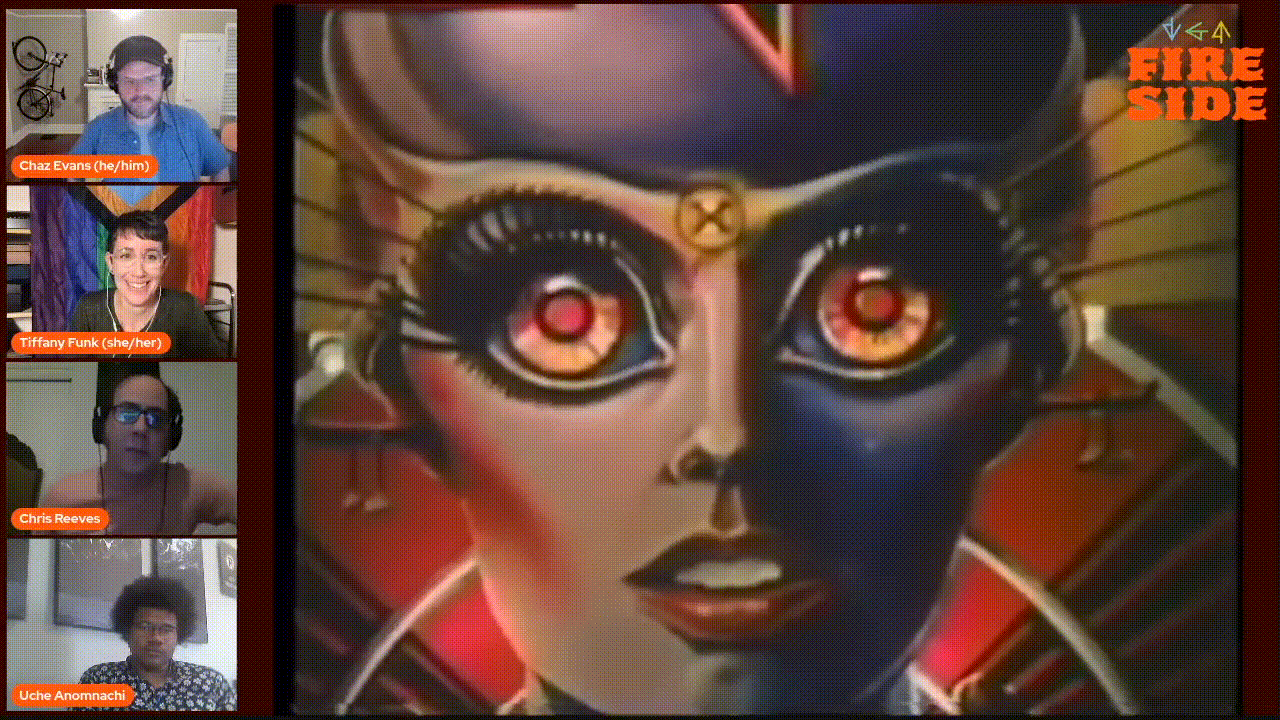VGA Fireside Ep. 14 feat. Uche Anomnachi, Tiffany Funk, and Chris Reeves: Highlights
To celebrate the release of VGA Reader Issue 4, Chaz Evans and co-host Tiffany Funk chat with special guests Uchechi Anomnachi and Chris Reeves for VGA Fireside Reader Edition! Together, they’ll discuss their contributions to this issue of VGA Reader, and their thoughts and perspectives on OVERCLOCKING.
Below are some of conversation highlights, edited for clarity and brevity. The full interview can be found on VGA Gallery’s YouTube and Twitch channels, where you can tune into the full conversation.
First, and foremost, what is overclocking?
Chaz Evans: It’s sort of a single word that we thought could store all the different conversations and feeds that can go in and out of this Issue. It’s a little piece of hardware jargon that’s commonly used by people trying to get the most performance out of their PC's while they’re playing video games. You know, using more than the processor was designed for in order to get that little bit of extra performance, power, value, or time. It was a metaphor that spoke to the crises in video games that are not separate from those in the world. Crises that deal with strained labor and trying to grow at a rate and capacity that might exceed what anything was designed for.
On the merits of short games
CE: We’ve got too many video games, which take a long time to make and are incredibly labor intensive. They also often take a long time to play. In fact, there’s a sort of virtue or premium on very long games as being more valued. At the same time, there are people with lives where there’s less and less time to play the games that are getting longer and longer. There’s also just so many games themselves, many of which will never get to see a player base. If we took all these strands together, we just see a whole lot of waste at the center or video game production.
There’s an object that symbolizes this sort of over acceleration of video game production and not enough time to play or make them: Steam calculator websites. These sites let you log into your Steam account and show you how many video games you own and how long it will take to complete all of them. When you put your information there, it’s sort of invariably approaching a human lifespan’s worth of entertainment.
Now, while we should still have beautiful, long and deep video game experiences, there’s an efficacy for the knowledge and reward for other categories of games, like short games. This seems kind of overly obvious, but we don’t have a popular, vernacular term for a category of video games the way we have a term like short film. So the piece recommends that we adopt this, and reward both the production and consumption of short games. Then, as the law of averages [impels], this should help with the problem of video game waste without censoring anyone or trying to tell anyone to do something that they don’t want to.
On the racial architecture of the Fighting Game Community and the hype spectacle
Tiffany Funk: What is it specifically about martial arts films and a lot of Southeast Asian media, like manga, that has historically attracted a lot of black American communities?
Uche Anomnachi: For some people, it’s the fact that the heroes simply weren’t white at a time when, if you wanted action spectacle, the options were white heroes or these outrageous black caricatures in the form of blaxploitation stars. This isn’t to say that black Americans didn’t love the white heroes or the blaxploitation stars, but there are specific undercurrents in martial arts media—especially in the ways of morality and resistance—that are embodied by the heroes. So when Bruce Lee is beating up like 30 ninjas at a time, he’s morally righteous, and a warrior for justice. That resonates with black audiences, and is what Amy Ongiri refers to as the nonwhite hero. It then becomes this culturally instantiated object, where for generations now, black people sort of uptake the admiration for martial arts action heroes that their parents, uncles, or older cousins had, and this creates a sort of long standing tradition.
TF: How would you define the hype spectacle, in terms of the fighting game community?
UA: Sure. In its original form, this paper was largely about the labor performed by the conduits of hype in the form of black casters—sometimes players, sometimes even just audience members. Hype is a bit different from general excitement. Rather than being something that’s experienced in an individual way, hype is something that is communal. This long history of communal consumption for video games, manga, anime movies, that is really the key thing that brings black Americans and hype in confluence to the fighting game community. Spectacle, then, is the way these hype moments get packaged and shipped across the Internet to represent excitement and enjoyment that one might get at a fighting game tournament or Smash Con.
Things like, Daigo Umehara Evo Moment #37, where he parries 15 consecutive attacks; it’s this very pure moment where the vehicle of the hype is the mechanical spectacle that everyone in the room just saw. Everyone feels it together, and they understand the insanity of what they're watching.
There’s this other version of hype mentioned in paper, exemplified by the famous “Wombo Combo.” What’s really the point of attraction is simply the fact that the caster, HomeMadeWaffles, or Brandon Collier, is the vehicle of the hype, and is just the performance of the black body work as disembodied voice that’s watching it.
CE: Along with the competition that is going on with fighting games, is there this meta-competition between different casters trying to produce better hype?
UA: I sort of rounded off the paper with a warning about the outsized development of this demand for hype, the way fans want to see moments like Evo Moment #37 all the time, its somewhat unsustainable, which is why I thought this piece was appropriate for the overclocking issue.
CE: So like hype happens and produces monetary value, but there’s a question like who gets to capture that?
UA: Right? Yeah. I think that clip (Evo Moment #37) is copyrighted, and someone owns that copyright.
On Suzanne Ciani and the voice of Xenon
TF: Who is Suzanne Ciani?
Chris Reeves: Ciani is probably most known for these new wave-y, ambient records from the late 70s, 80s, and into the 90s. But before that, and kind of simultaneous to it, she was a pioneer on this electronic musical instrument called the buchla—a very complicated synthesizer and a really difficult thing to play. So somewhere into the early 70s, she begins to get commissioned to do these sort of strange cybernetic-ish compositions for these—the clientele ranges from GE dishwashers to Merill Lynch—commercial entities. Her compositions had this sort of unique feature of being more rooted in an electronic avant garde compositional world, think more John Cage and less commercial design music.
CR: A vignette I used in the article is one of those pinball repair videos, where the repairman is talking about this famous Bally pinball machine, Xenon. He says that this is the first pinball machine to utilize a female voice, and the voice belongs to a nameless, faceless secretary at Bally. It’s really interesting to think about the way that some networks don’t intercede, because in experimental music and maybe the gaming world as well, Suzanne Ciani is very well known for being the first female voice of the Xenon. But at a sort of midpoint level, where there’s somebody who repairs and fixes the machine and makes sure it stays in rotation, essentially has no clue. It’s sort of an interesting thing to examine, how two or three networks of kind of general music and games kind of collide and don’t in interesting ways, with Ciani not quite fitting anything into any of those spaces either.
CR: What I thought was interesting about the idea of the commission is that she’s going into Bally headquarters and seeing a big breasted robot that is going to be used for this [pinball] machine, but she’s hoping to imbue it with something bigger than that; give it more humanity, something more substantial than just evil cyborg woman, or the idea that technology is gendered. She’s simultaneously leaning into the strangeness of it, but at the same time committed to her actual ideological beliefs, like technology has feelings, technology has a humanity to it, and I’m a passive vessel that makes that happen.






